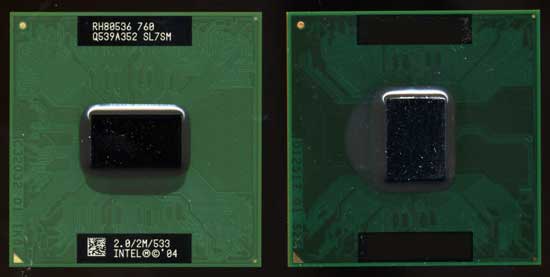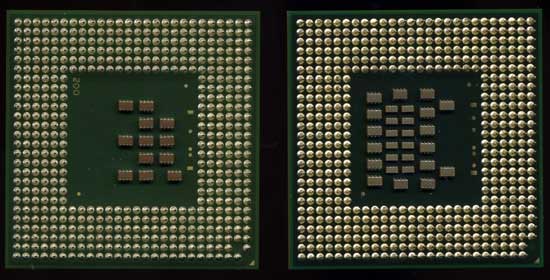Intel Core Duo (Yonah) Performance Preview - Part II
by Anand Lal Shimpi on December 19, 2005 12:55 PM EST- Posted in
- CPUs
It's called the Core Duo
When Yonah first started appearing on roadmaps, we knew it as Jonah, which then starting being written as Yonah. Eventually, Intel confirmed its existence and we had always assumed that it would continue to use the name Pentium M. However, given the great importance of the launch of Intel's first dual-core, low power, notebook processor, it shouldn't be much of a surprise that Intel has a new name in store for it. As you've probably already heard, Yonah will receive the marketing name "Core" with the words "Duo" or "Solo" following it depending on whether it is the dual or single core version. The name Centrino will still be there, but instead of referring to the processor as a Pentium M, it'll be called a Core Duo or a Core Solo. The Centrino platform itself will be referred to as Centrino Duo when paired with a Core Duo processor. We have to admit, we kind of like the new name.
Not so pleasant, however, are the new processor numbers that go along with the new processor names. Gone are Intel's simple three-digit numbers and they have since been replaced with a four-digit number preceded by a letter. The letter indicates the thermal envelope of the processor, while the following four digits denote the performance level of the CPU. If you think that this sounds oddly similar to AMD's Turion processor nomenclature, don't worry; you'd be completely right (of course, the Turion only uses two numbers, while Core Duo uses four). Maybe, one of these days, Intel will get around to copying some more important elements of AMD's history, such as an on-die memory controller or at least a serial bus interface.
As an example of the numbers in use, the 2.0GHz processor that we previewed in the first article will be sold under the name "Intel Core Duo T2500". For your reference, the T2600 will run at 2.16GHz (compared to the 2.0GHz T2500). The Core Solo processors will feature a "1" after the "T" denoting a single core; for example, the Intel Core Solo T1300 will run at 1.66GHz.
Intel's Core Duo and Solo processors both support a 667MHz FSB, which is enabled by the 945 chipset that Intel is pairing with them. The move to a 667MHz FSB is necessary, thanks to the increased bandwidth demands of a dual core processor.
As we mentioned in the first article, the Core Duo (and Solo) processors are not pin-compatible with the older Pentium M, even though they physically have the same number of pins.
When Yonah first started appearing on roadmaps, we knew it as Jonah, which then starting being written as Yonah. Eventually, Intel confirmed its existence and we had always assumed that it would continue to use the name Pentium M. However, given the great importance of the launch of Intel's first dual-core, low power, notebook processor, it shouldn't be much of a surprise that Intel has a new name in store for it. As you've probably already heard, Yonah will receive the marketing name "Core" with the words "Duo" or "Solo" following it depending on whether it is the dual or single core version. The name Centrino will still be there, but instead of referring to the processor as a Pentium M, it'll be called a Core Duo or a Core Solo. The Centrino platform itself will be referred to as Centrino Duo when paired with a Core Duo processor. We have to admit, we kind of like the new name.
Not so pleasant, however, are the new processor numbers that go along with the new processor names. Gone are Intel's simple three-digit numbers and they have since been replaced with a four-digit number preceded by a letter. The letter indicates the thermal envelope of the processor, while the following four digits denote the performance level of the CPU. If you think that this sounds oddly similar to AMD's Turion processor nomenclature, don't worry; you'd be completely right (of course, the Turion only uses two numbers, while Core Duo uses four). Maybe, one of these days, Intel will get around to copying some more important elements of AMD's history, such as an on-die memory controller or at least a serial bus interface.
As an example of the numbers in use, the 2.0GHz processor that we previewed in the first article will be sold under the name "Intel Core Duo T2500". For your reference, the T2600 will run at 2.16GHz (compared to the 2.0GHz T2500). The Core Solo processors will feature a "1" after the "T" denoting a single core; for example, the Intel Core Solo T1300 will run at 1.66GHz.
Intel's Core Duo and Solo processors both support a 667MHz FSB, which is enabled by the 945 chipset that Intel is pairing with them. The move to a 667MHz FSB is necessary, thanks to the increased bandwidth demands of a dual core processor.
As we mentioned in the first article, the Core Duo (and Solo) processors are not pin-compatible with the older Pentium M, even though they physically have the same number of pins.

Dothan (Pentium M) on the left, Yonah (Core Duo) on the Right

Dothan (Pentium M) on the left, Yonah (Core Duo) on the Right










103 Comments
View All Comments
mitcoes - Saturday, April 22, 2006 - link
The msot important question about corel duo, is if dual processors Apple Machines with ATI X1900XT woul be a better machine than AMD and Pentium with one processor at same clocks. Better when core duo would arrive to 3 Mhz or nearby. Becouse hard gamers, and renderers would buy this (expending a few more bucks) and have the choice of use MAC OS, Win XP, an Linux on the same machine with opengl games probably going better in Leopard than in XP becouse of the better networking of UNIX and Linux over TCP/IP. The test of packets losed with Quake3 XP vs Leopard would be a great test, becouse probably AMD, and Pentium with same clocks and ATI would have similar preformance in games that are not prepared for two processors, but Photoshop CS2, blender And other CAD/CAM apps would run better. Perhaps The future new market of Apple machines are hard gamers, and hard users like architects, renderers, animators and so one. But it must be tested. And I want to know if MAC mainboards are better than ASUS and Gigabyte ones (or other better if them exists).Cygni - Wednesday, December 21, 2005 - link
Congrat AT commenters! I have to say, this is the new HIGH SCORE for useless, incorrect, biased, self important posts in the history of AT!Really, i was going to respond to each one in turn, but I think its far easier just to make this one post where i point out that many, many, many of you should likely try lurking a bit instead of instantly hitting the reply button and spouting off about latencys, bus widths, and other thing your Toms Hardware Education degree has certified you an expert at. We will all be more intelligent if you didnt post.
IntelUser2000 - Tuesday, December 20, 2005 - link
They should have used low latency DDR2-533 rather than the normal JEDEC specified 4-4-4-12 latency for their reviews. It might be faster then :)).Also, testing Sonoma notebooks have shown that it likes single channel DDR2-533 better than DDR2-400, like how it doesn't benefit from dual channel. I would also like to see DDR2-667 results(over dual channel DDR2-533), as few % here and there will really show Yonah's potential.
coldpower27 - Tuesday, December 20, 2005 - link
Yes that would be interesting, as Anantech does have Corsair DDR2-667 3-2-2-8 available in their repitoire.StuckMojo - Tuesday, December 20, 2005 - link
I'd like to see compilation benchmarks. Lots of us use our laptops for software development.
Betwon - Tuesday, December 20, 2005 - link
Compilation?At the recent Spec CPU Cint2000 test--The most fast x86 CPU about compiler is P4 670.
176.gcc 2195/2195 ponits
PM@2.26GHz(1995/1994) is fast than FX-55@2.6GHz(1931/1933).
IntelUser2000 - Tuesday, December 20, 2005 - link
If any of you actually care to search for transistor performance of Intel's and AMD/IBM, you can see that AMD/IBM's the newest 65nm process is only 2-3% faster but Intel is providing the numbers at HALF the leakage.There WILL be X2 clock speed like versions of Yonah with higher TDP and being graded as EE.
-Equal platform comparisons are never possible.
-DDR2's power advantage isn't as great as you think.
-We don't know if Turion would benefit at all from DDR2 in performance, the claimed 15% or so is at best case, aka single benchmark. It always happens, companies say some wonder number and in reality its even worse than the previous one.
Betwon - Tuesday, December 20, 2005 - link
The very low latency of L2 cache is the main real reason? AT may be foreget that L2 can be shared, which is different with AMD.Schmide - Tuesday, December 20, 2005 - link
Correct me if I'm wrong. Doesn't the AMD architecture have a 3 cycle L1 latency due to an exclusive L1 L2 cache relationship. While Intel uses a 2 cycle L1 inclusive L1 L2 cache relationship. With the larger cache sizes now, the more costly exclusive set seems to be holding AMD back. However, this higher latency could be the reason AMD is able to reach higher speeds using a lower process.As for the power consumption, I wonder if the board design had anything to do with the X2 being 30% higher. Chime in here
On die memory controller advantage AMD.
DDR2 lower power consumption advantage Intel
65nm process advantage Intel
Mature SOI advantage AMD.
Betwon - Tuesday, December 20, 2005 - link
You are wrong about the cache of Yonah. The mobile CPU is different with the Netburst.Yonah's L1 latency is 3 cycles, and it is a kind of write-back cache, which needs not always copy the data to L2. L2 latency is 14 cycles(AT said), which is the same with AthonX2. And Yonah's number of pipeline stages is 11,12, or 13. The AthonX2 is 12-stage. So, (Include AT)we believe that Yonah can reach the high frequency. The real reason of Yonah only max 2.16GHz -- for the moblie applications ... to control the power sum.